Test–Retest Reliability of Ankle Mobility, Balance, and Jump Tests in Amateur Trail Running Athletes
Abstract
1. Introduction
2. Methodology
2.1. Sample Size Calculation
2.2. Participants
2.3. Materials and Instruments
- Lunge Test (Weight-Bearing Lunge Test, WBLT): The WBLT evaluates ankle dorsiflexion in a closed kinetic chain. It consists of touching the wall with the knee while placing the foot as far from the wall as possible without lifting the heel from the ground. Reduced ankle dorsiflexion is associated with a greater risk of lower-limb injuries during sports practice [31]. This is considered a reliable tool for assessing ankle dorsiflexion in healthy populations [32].
- Y Balance Test (YBT): The YBT is a tool designed to assess dynamic balance, core stability, postural control, and functional symmetry between lower limbs. It has proven to be highly reliable in healthy adults [33], military populations [34], and runners with intellectual disabilities [35], as well as a predictor of injury risk. The test consists of reaching as far as possible with the tip of the foot in three directions (anterior, posteromedial, and posterolateral) while maintaining single-leg balance without losing stability.
- Hop Test Battery: This battery includes 4 single-leg hop tests (Single Hop Test, Triple Hop Test, Crossover Hop Test, and 6m Timed Hop Test), which are used to evaluate explosive strength, dynamic stability, and inter-limb symmetry through the Limb Symmetry Index (LSI), particularly after musculoskeletal injuries [36,37], in order to determine the functional capacity of the injured leg compared to the healthy one. These tests have also been proven reliable in healthy populations [38,39,40].
- Countermovement Jump (CMJ): The CMJ is one of the most valid and reliable tests to assess lower-limb power across diverse populations, including elite athletes, adolescents, and runners from different athletic disciplines [41]. It shows significant correlations with markers of fatigue and with higher athletic performance among middle and long-distance runners [42]. The test consists of starting from a fully upright position, performing a rapid downward movement (countermovement), and then vertically jumping, taking advantage of the stretch-shortening cycle [43].
2.4. Test–Retest Procedure
2.5. Statistical Analysis
3. Results
4. Discussion
5. Conclusions
Author Contributions
Funding
Institutional Review Board Statement
Informed Consent Statement
Data Availability Statement
Acknowledgments
Conflicts of Interest
Abbreviations
| BMI | Body Mass Index |
| CI | Confidence Interval |
| CMJ | Countermovement Jump |
| ICC | Intraclass Correlation Coefficient |
| LOA | Limits Of Agreement |
| MAS | Maximal Aerobic Speed |
| MDC | Minimal Detectable Change |
| SD | Standard Deviation |
| SEM | Standard Error of Measurement |
| WBLT | Weight-Bearing Lunge Test |
| YBT | Y Balance Test |
References
- Zagalaz, L.; De Jaén, U.; Latorre, P.; De Jaén, R.U. Intervención Del Profesorado de Educación Física En El Turismo Activo. Actividades Turístico-Recreativo-Deportivas En Jaén. Retos 2002, 3, 17–24. [Google Scholar] [CrossRef]
- Jiménez-Redondo, G.; Castro-Frecha, B.; Martínez-Noguera, F.J.; Alcaraz, P.; Marín-Pagán, C. Physiological Responses in Trail Runners during a Maximal Test with Different Weighted-Vest Loads. Sports 2024, 12, 189. [Google Scholar] [CrossRef]
- Vernillo, G.; Giandolini, M.; Edwards, W.B.; Morin, J.B.; Samozino, P.; Horvais, N.; Millet, G. Biomechanics and Physiology of Uphill and Downhill Running. Sports Med. 2017, 47, 615–629. [Google Scholar] [CrossRef] [PubMed]
- Di Prampero, P.E.; Atchou, G.; Brückner, J.C.; Moia, C. The Energetics of Endurance Running. Eur. J. Appl. Physiol. Occup. Physiol. 1986, 55, 259–266. [Google Scholar] [CrossRef] [PubMed]
- Balducci, P.; Clémençon, M.; Trama, R.; Blache, Y.; Hautier, C. Performance Factors in a Mountain Ultramarathon. Int. J. Sports Med. 2017, 38, 819–826. [Google Scholar] [CrossRef] [PubMed]
- Martínez Navarro, I. Trail Running: Ciencia y Entrenamiento; Sportraining: Madrid, Spain, 2021; Volume 1, pp. 5–241. [Google Scholar]
- Alvero-Cruz, J.R.; Parent Mathias, V.; Garcia Romero, J.; Carrillo de Albornoz-Gil, M.; Benítez-Porres, J.; Ordoñez, F.J.; Rosemann, T.; Nikolaidis, P.T.; Knechtle, B. Prediction of Performance in a Short Trail Running Race: The Role of Body Composition. Front. Physiol. 2019, 10, 489288. [Google Scholar] [CrossRef]
- Ehrström, S.; Tartaruga, M.; Easthope, C.; Brisswalter, J.; Morin, J.B.; Vercruyssen, F. Short Trail Running Race: Beyond the Classic Model for Endurance Running Performance. Med. Sci. Sports Exerc. 2018, 50, 580–588. [Google Scholar] [CrossRef]
- Scheer, V.; Janssen, T.; Vieluf, S.; Heitkamp, H.C. Predicting Trail-Running Performance with Laboratory Exercise Tests and Field-Based Results. Int. J. Sports Physiol. Perform. 2019, 14, 130–133. [Google Scholar] [CrossRef]
- Casado, A.; Tuimil, J.L.; Iglesias, X.; Fernández-Del-Olmo, M.; Jiménez-Reyes, P.; Martín-Acero, R.; Rodríguez, F.A. Maximum Aerobic Speed, Maximum Oxygen Consumption, and Running Spatiotemporal Parameters during an Incremental Test among Middle- and Long-Distance Runners and Endurance Non-Running Athletes. PeerJ 2022, 10, e14035. [Google Scholar] [CrossRef]
- Fornasiero, A.; Savoldelli, A.; Fruet, D.; Boccia, G.; Pellegrini, B.; Schena, F. Physiological Intensity Profile, Exercise Load and Performance Predictors of a 65-Km Mountain Ultra-Marathon. J. Sports Sci. 2018, 36, 1287–1295. [Google Scholar] [CrossRef]
- Martinez-Navarro, I.; Montoya-Vieco, A.; Collado, E.; Hernando, B.; Hernando, C. Ultra Trail Performance Is Differently Predicted by Endurance Variables in Men and Women. Int. J. Sports Med. 2022, 43, 600–607. [Google Scholar] [CrossRef]
- Rønnestad, B.R. Mujika Optimizing Strength Training for Running and Cycling Endurance Performance: A Review. Scand. J. Med. Sci. Sports 2014, 24, 603–612. [Google Scholar] [CrossRef] [PubMed]
- Llanos-Lagos, C.; Ramirez-Campillo, R.; Moran, J.; Sáez de Villarreal, E. Effect of Strength Training Programs in Middle- and Long-Distance Runners’ Economy at Different Running Speeds: A Systematic Review with Meta-Analysis. Sports Med. 2024, 54, 895–932. [Google Scholar] [CrossRef] [PubMed]
- Giandolini, M.; Horvais, N.; Rossi, J.; Millet, G.Y.; Morin, J.-B.; Samozino, P. Effects of the Foot Strike Pattern on Muscle Activity and Neuromuscular Fatigue in Downhill Trail Running. Scand. J. Med. Sci. Sports 2017, 27, 809–819. [Google Scholar] [CrossRef] [PubMed]
- Rao, Y.; Yang, N.; Gao, T.; Zhang, S.; Shi, H.; Lu, Y.; Ren, S.; Huang, H. Effects of Peak Ankle Dorsiflexion Angle on Lower Extremity Biomechanics and Pelvic Motion during Walking and Jogging. Front. Neurol. 2024, 14, 1269061. [Google Scholar] [CrossRef]
- Garmash, I.A.; Kozina, Z.L. Postural Balance and Running Technique: Is There a Relationship? Review Article. Health-Sav. Technol. Rehabil. Phys. Ther. 2021, 2, 33–38. [Google Scholar] [CrossRef]
- Chaudhari, A.; van Horn, M.; Monfort, S.; Pan, X.; Oñate, J.; Best, T. Reducing Core Stability Influences Lower Extremity Biomechanics in Novice Runners. Med. Sci. Sports Exerc. 2020, 52, 1347. [Google Scholar] [CrossRef]
- Taipale, R.; Mikkola, J.; Salo, T.; Hokka, L.; Vesterinen, V.; Kraemer, W.; Nummela, A.; HäKkinen, K. Mixed Maximal and Explosive Strength Training in Recreational Endurance Runners. J. Strength Cond. Res. 2014, 28, 689–699. [Google Scholar] [CrossRef]
- Easthope, C.S.; Nosaka, K.; Caillaud, C.; Vercruyssen, F.; Louis, J.; Brisswalter, J. Reproducibility of Performance and Fatigue in Trail Running. J. Sci. Med. Sport 2014, 17, 207–211. [Google Scholar] [CrossRef]
- Jaén-Carrillo, D.; García-Pinillos, F.; Alcaraz, P.E.; Marín-Pagán, C.; Martínez-Noguera, F.J.; Federolf, P.A. Jump Performance and Handgrip Strength Do Not Reflect Acute Fatigue in Elite Trail Runners after the 2023 World Trail Running Championship. Front. Sports Act Living 2025, 7, 1506067. [Google Scholar] [CrossRef]
- Lemire, M.; Hureau, T.J.; Favret, F.; Geny, B.; Kouassi, B.Y.L.; Boukhari, M.; Lonsdorfer, E.; Remetter, R.; Dufour, S.P. Physiological Factors Determining Downhill vs Uphill Running Endurance Performance. J. Sci. Med. Sport 2021, 24, 85–91. [Google Scholar] [CrossRef]
- Svenningsen, F.P.; Pavailler, S.; Giandolini, M.; Horvais, N.; Madeleine, P. A Narrative Review of Potential Measures of Dynamic Stability to Be Used during Outdoor Locomotion on Different Surfaces. Sports Biomech. 2020, 19, 120–140. [Google Scholar] [CrossRef]
- Debertin, D.; Wargel, A.; Mohr, M. Reliability of Xsens IMU-Based Lower Extremity Joint Angles during in-Field Running. Sensors 2024, 24, 871. [Google Scholar] [CrossRef]
- Vaz, S.; Falkmer, T.; Passmore, A.E.; Parsons, R.; Andreou, P. The Case for Using the Repeatability Coefficient When Calculating Test–Retest Reliability. PLoS ONE 2013, 8, e73990. [Google Scholar] [CrossRef] [PubMed]
- Atkinson, G.; Nevill, A. Statistical Methods for Assessing Measurement Error (Reliability) in Variables Relevant to Sports Medicine. Sports Med. 1998, 26, 217–238. [Google Scholar] [CrossRef] [PubMed]
- Weir, J. Quantifying Test-Retest Reliability Using the Intraclass Correlation Coefficient and the SEM. J. Strength. Cond. Res. 2005, 19, 231–240. [Google Scholar] [CrossRef] [PubMed]
- Koo, T.; Li, M. A Guideline of Selecting and Reporting Intraclass Correlation Coefficients for Reliability Research. J. Chiropr. Med. 2016, 15, 155–163. [Google Scholar] [CrossRef]
- McKay, A.K.A.; Stellingwerff, T.; Smith, E.S.; Martin, D.T.; Mujika, I.; Goosey-Tolfrey, V.L.; Sheppard, J.; Burke, L.M. Defining Training and Performance Caliber: A Participant Classification Framework. Int. J. Sports Physiol. Perform. 2021, 17, 317–331. [Google Scholar] [CrossRef]
- Pueo, B.; Penichet-Tomas, A.; Jimenez-Olmedo, J. Reliability and Validity of the Chronojump Open-Source Jump Mat System. Biol. Sport 2020, 37, 255–259. [Google Scholar] [CrossRef]
- Pope, R.; Herbert, R.; Kirwan, J. Effects of Ankle Dorsiflexion Range and Pre-Exercise Calf Muscle Stretching on Injury Risk in Army Recruits. Aust. J. Physiother. 1998, 44, 165–172. [Google Scholar] [CrossRef]
- Powden, C.; Hoch, J.; Hoch, M. Reliability and Minimal Detectable Change of the Weight-Bearing Lunge Test: A Systematic Review. Man. Ther. 2015, 20, 524–532. [Google Scholar] [CrossRef]
- Plisky, P.; Schwartkopf-Phifer, K.; Huebner, B.; Garner, M.B.; Bullock, G. Systematic Review and Meta-Analysis of the y-Balance Test Lower Quarter: Reliability, Discriminant Validity, and Predictive Validity. Int. J. Sports Phys. Ther. 2021, 16, 1190–1209. [Google Scholar] [CrossRef]
- Shaffer, S.; Teyhen, D.; Lorenson, C.; Warren, R.; Koreerat, C.; Straseske, C.; Childs, J. Y-Balance Test: A Reliability Study Involving Multiple Raters. Mil. Med. 2013, 178, 1264–1270. [Google Scholar] [CrossRef]
- Jouira, G.; Rebai, H.; Sahli, S. Reliability of Y Balance Test in Runners With Intellectual Disability. J. Sport Rehabil. 2023, 32, 91–95. [Google Scholar] [CrossRef]
- Noyes, F.R.; Barber, S.D.; Mangine, R.E. Abnormal Lower Limb Symmetry Determined by Function Hop Tests after Anterior Cruciate Ligament Rupture. Am. J. Sports Med. 1991, 19, 513–518. [Google Scholar] [CrossRef]
- Logerstedt, D.; Grindem, H.; Lynch, A.; Eitzen, I.; Engebretsen, L.; Risberg, M.A.; Axe, M.J.; Snyder-Mackler, L. Single-Legged Hop Tests as Predictors of Self-Reported Knee Function after Anterior Cruciate Ligament Reconstruction: The Delaware-Oslo ACL Cohort Study. Am. J. Sports Med. 2012, 40, 2348–2356. [Google Scholar] [CrossRef] [PubMed]
- Bolgla, L.; Keskula, D. Reliability of Lower Extremity Functional Performance Tests. J. Orthop. Sports Phys. Ther. 1997, 26, 138–142. [Google Scholar] [CrossRef] [PubMed]
- Munro, A.; Herrington, L. Between-Session Reliability of Four Hop Tests and the Agility T-Test. J. Strength. Cond. Res. 2011, 25, 1470–1477. [Google Scholar] [CrossRef] [PubMed]
- Simms, S. The Test-Retest Reliability of a Novel Single Leg Hop Test. In Proceedings of the S4 Georgia Southern Student Scholars Symposium, Virtual, 12–16 April 2021. [Google Scholar]
- Bagchi, A.; Raizada, S.; Thapa, R.; Stefanica, V.; Ceylan, H.İ. Reliability and Accuracy of Portable Devices for Measuring Countermovement Jump Height in Physically Active Adults: A Comparison of Force Platforms, Contact Mats, and Video-Based Software. Life 2024, 14, 1394. [Google Scholar] [CrossRef]
- Balsalobre-Fernández, C.; Ma Tejero-González, C.; Del Campo-Vecino, J. Hormonal and Neuromuscular Responses to High-Level Middle- and Long-Distance Competition. Int. J. Sports Physiol. Perform. 2014, 9, 839–844. [Google Scholar] [CrossRef]
- Petrigna, L.; Karsten, B.; Marcolin, G.; Paoli, A.; D’Antona, G.; Palma, A.; Bianco, A. A Review of Countermovement and Squat Jump Testing Methods in the Context of Public Health Examination in Adolescence: Reliability and Feasibility of Current Testing Procedures. Front. Physiol. 2019, 10, 1384. [Google Scholar] [CrossRef]
- Munro, B.H. Statistical Methods for Health Care Research—Softcover; Lippincott Williams & Wilkins: Philadelphia, PA, USA, 2005; ISBN 0781748402. [Google Scholar]
- Smidt, N.; van der Windt, D.A.; Assendelft, W.J.; Mourits, A.J.; Devillé, W.L.; de Winter, A.F.; Bouter, L.M. Interobserver Reproducibility of the Assessment of Severity of Complaints, Grip Strength, and Pressure Pain Threshold in Patients with Lateral Epicondylitis. Arch. Phys. Med. Rehabil. 2002, 83, 1145–1150. [Google Scholar] [CrossRef]
- De Oliveira, M.P.B.; Calixtre, L.B.; da Silva Serrão, P.R.M.; de Oliveira Sato, T.; de Medeiros Takahashi, A.C.; de Andrade, L.P. Reproducibility of Isokinetic Measures of the Knee and Ankle Muscle Strength in Community-Dwelling Older Adults without and with Alzheimer’s Disease. BMC Geriatr. 2022, 22, 940. [Google Scholar] [CrossRef]
- Martin Bland, J.; Altman, D.G. Statistical Methods for Assessing Agreement Between Two Methods of Clinical Measurement. Lancet 1986, 327, 307–310. [Google Scholar] [CrossRef]
- Bennell, K.; Talbot, R.; Wajswelner, H.; Techovanich, W.; Kelly, D. Intra-Rater and Inter-Rater Reliability of a Weight-Bearing Lunge Measure of Ankle Dorsiflexion. Aust. J. Physiother. 1998, 44, 175–180. [Google Scholar] [CrossRef]
- Chisholm, M.; Birmingham, T.; Brown, J.; MacDermid, J.; Chesworth, B. Reliability and Validity of a Weight-Bearing Measure of Ankle Dorsiflexion Range of Motion. Physiother. Can. 2012, 64, 347–355. [Google Scholar] [CrossRef]
- Zając, B.; Olszewski, M.; Mika, A. Influence of Protocol Variables on Outcomes of the Star Excursion Balance Test Group (SEBT, MSEBT, YBT-LQ) in Healthy Individuals: A Systematic Review. Front. Physiol. 2024, 15, 1415887. [Google Scholar] [CrossRef]
- Drum, S.N.; Rappelt, L.; Held, S.; Donath, L. Effects of Trail Running versus Road Running—Effects on Neuromuscular and Endurance Performance—A Two Arm Randomized Controlled Study. Int. J. Env. Res. Public Health 2023, 20, 4501. [Google Scholar] [CrossRef]
- Riera, J.; Duclos, N.C.; Néri, T.; Rambaud, A.J. Is There Any Biomechanical Justification to Use Hopping as a Return to Running Test? A Cross-Sectional Study. Phys. Ther. Sport 2023, 61, 135–141. [Google Scholar] [CrossRef]
- Dominguez-Navarro, F.; Casaña, J.; Perez-Dominguez, B.; Ricart-Luna, B.; Cotolí-Suárez, P.; Calatayud, J. Dynamic Balance and Explosive Strength Appears to Better Explain Single Leg Hop Test Results among Young Elite Female Basketball Athletes. Sci. Rep. 2023, 13, 5476. [Google Scholar] [CrossRef]
- Schelin, L.; Pini, A.; Markström, J.L.; Häger, C.K. Test-Retest Reliability of Entire Time-Series Data from Hip, Knee and Ankle Kinematics and Kinetics during One-Leg Hops for Distance: Analyses Using Integrated Pointwise Indices. J. Biomech. 2021, 124, 110546. [Google Scholar] [CrossRef]
- Ashby, B.M.; Heegaard, J.H. Role of Arm Motion in the Standing Long Jump. J. Biomech. 2002, 35, 1631–1637. [Google Scholar] [CrossRef]
- Multhuaptff, W.; Fernández-Peña, E.; Moreno-Villanueva, A.; Soler-López, A.; Rico-González, M.; Clemente, F.M.; Bravo-Cucci, S.; Pino-Ortega, J. Concurrent-Validity and Reliability of Photocells in Sport: A Systematic Review. J. Hum. Kinet. 2023, 92, 53. [Google Scholar] [CrossRef]
- Warr, D.; Pablos, C.; Sánchez-Alarcos, J.; Torres, V.; Izquierdo, J.; Carlos Redondo, J. Reliability of Measurements during Countermovement Jump Assessments: Analysis of Performance across Subphases. Cogent Soc. Sci. 2020, 6, 1843835. [Google Scholar] [CrossRef]
- Heishman, A.; Daub, B.; Miller, R.; Freitas, E.; Frantz, B.; Bemben, M. Countermovement Jump Reliability Performed With and Without an Arm Swing in NCAA Division 1 Intercollegiate Basketball Players. J. Strength. Cond. Res. 2020, 34, 546–558. [Google Scholar] [CrossRef] [PubMed]
- Kodete, C.S.; Thuraka, B.; Pasupuleti, V.; Malisetty, S. Hormonal Influences on Skeletal Muscle Function in Women across Life Stages: A Systematic Review. Muscles 2024, 3, 271–286. [Google Scholar] [CrossRef] [PubMed]
- Elorduy-Terrado, A.; Torres-Luque, G.; Radesca, K.; Muñoz-Andradas, G.; Saenz-Bravo, M.; Domínguez-Balmaseda, D. Evaluation the Impact of Hormonal Fluctuations during the Menstrual Cycle on the Performance of Female Athletes—Systematic Review. Muscles 2025, 4, 15. [Google Scholar] [CrossRef]
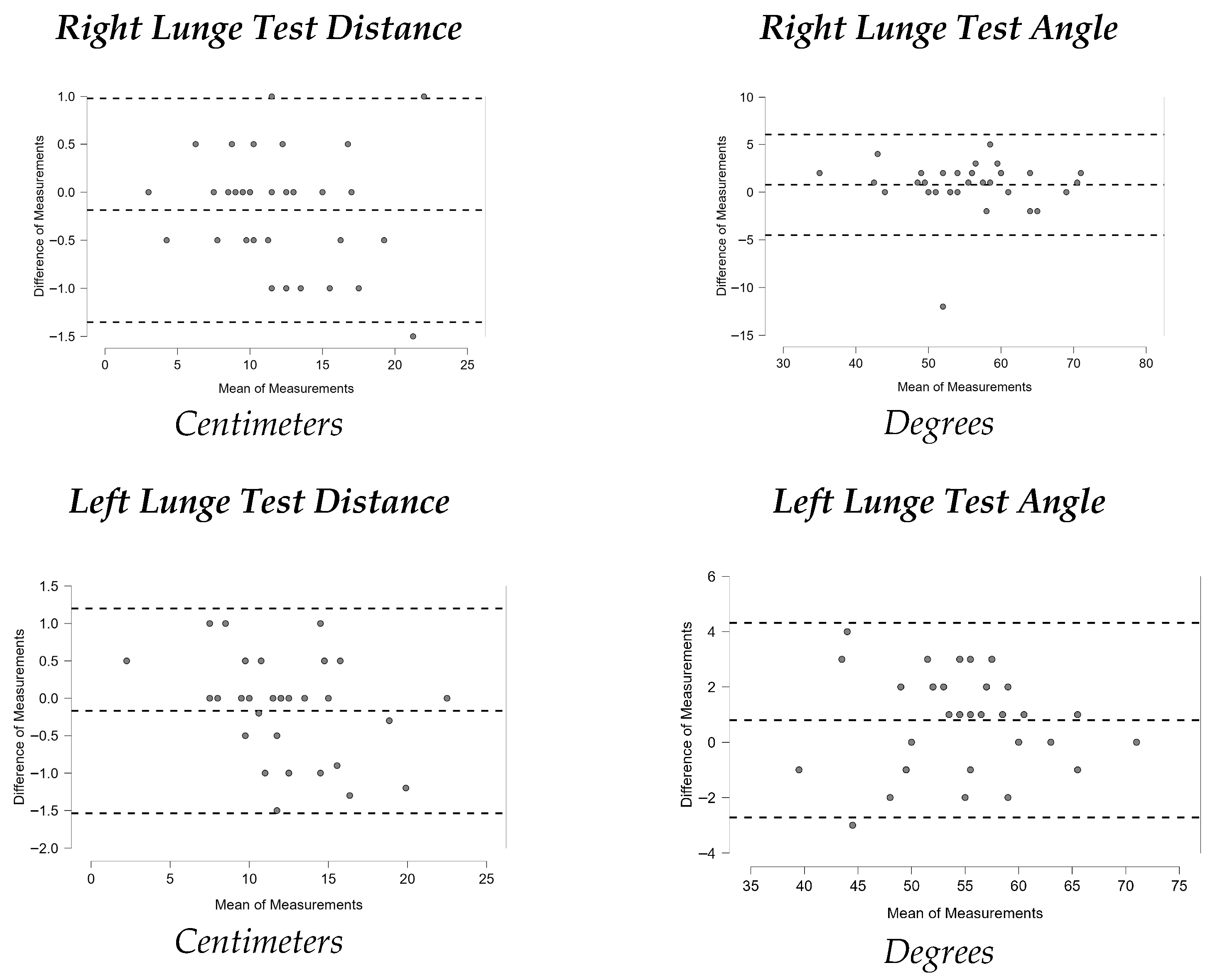
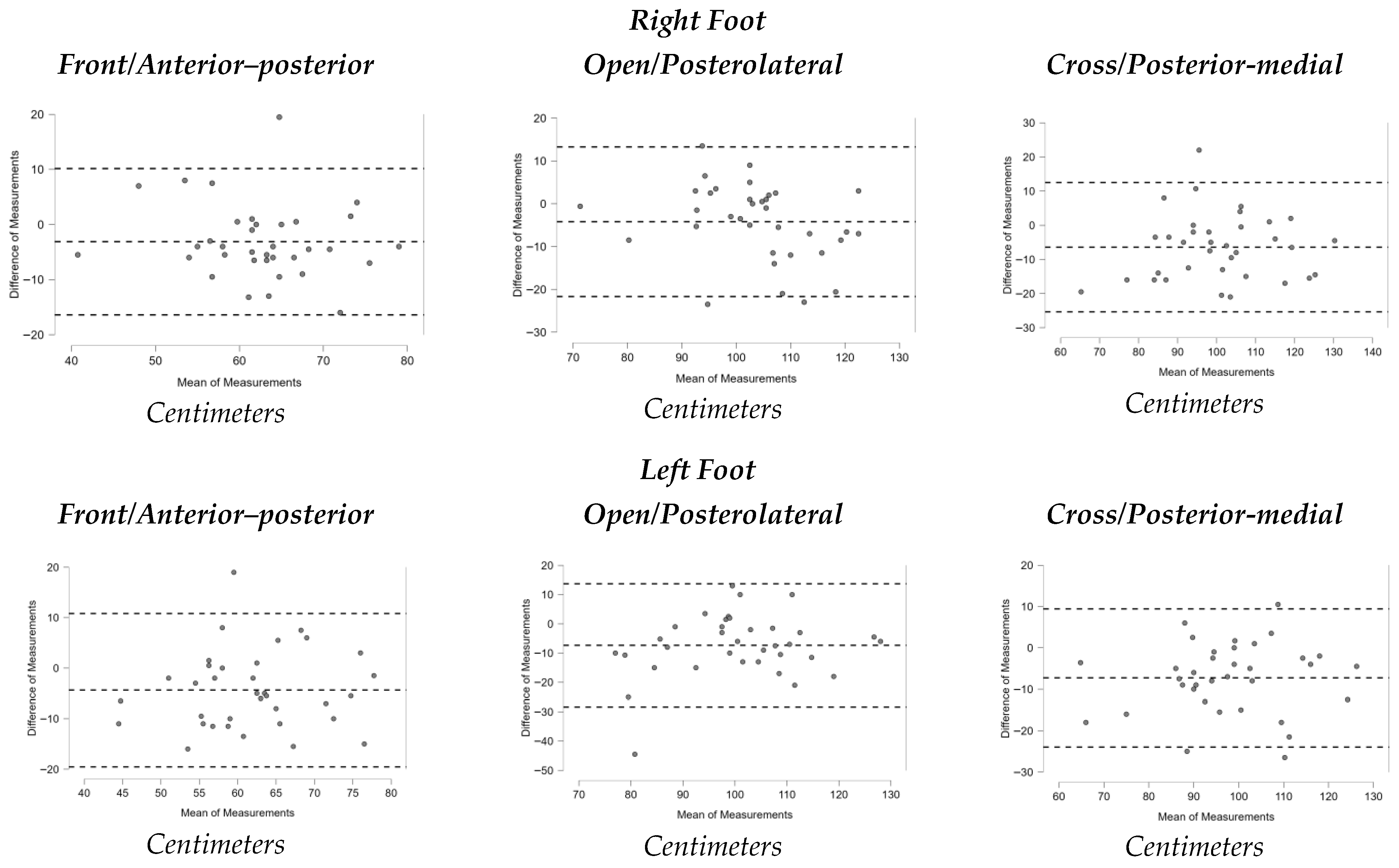
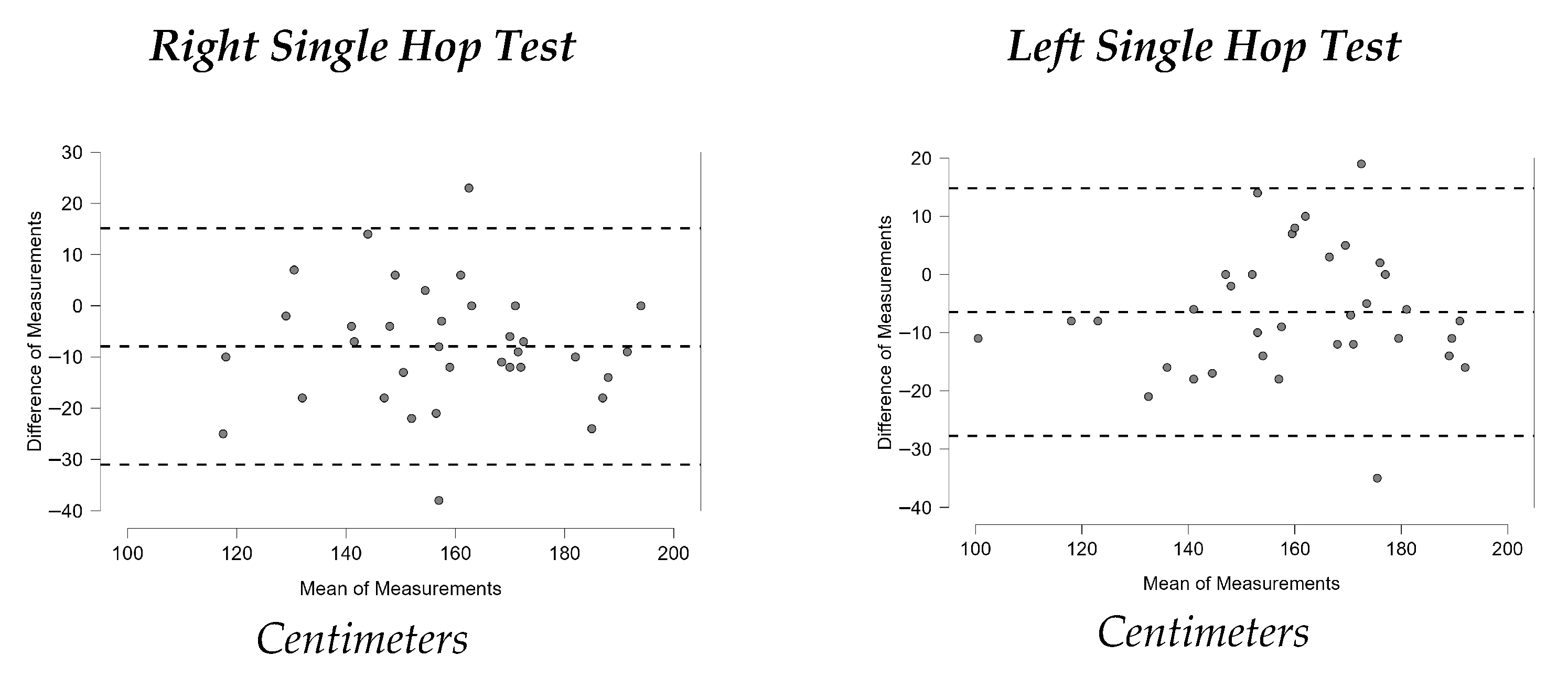
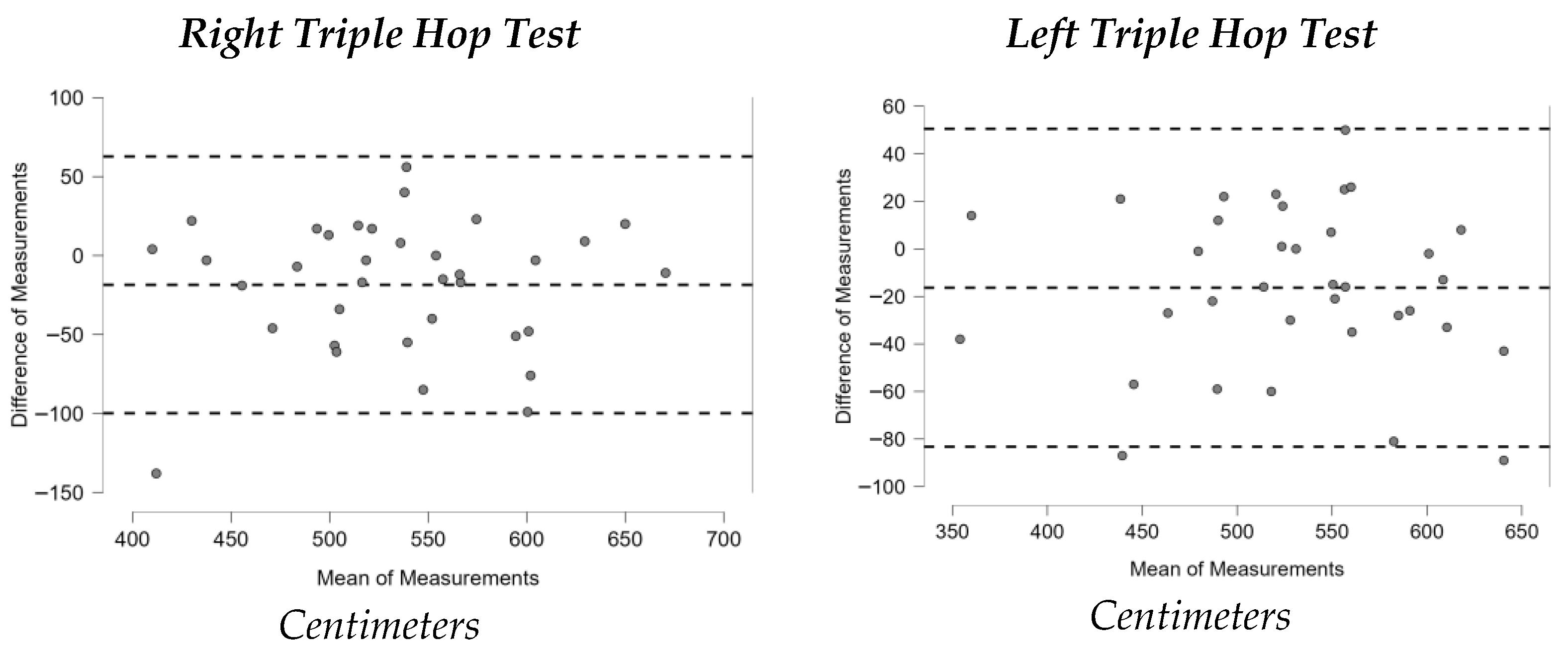
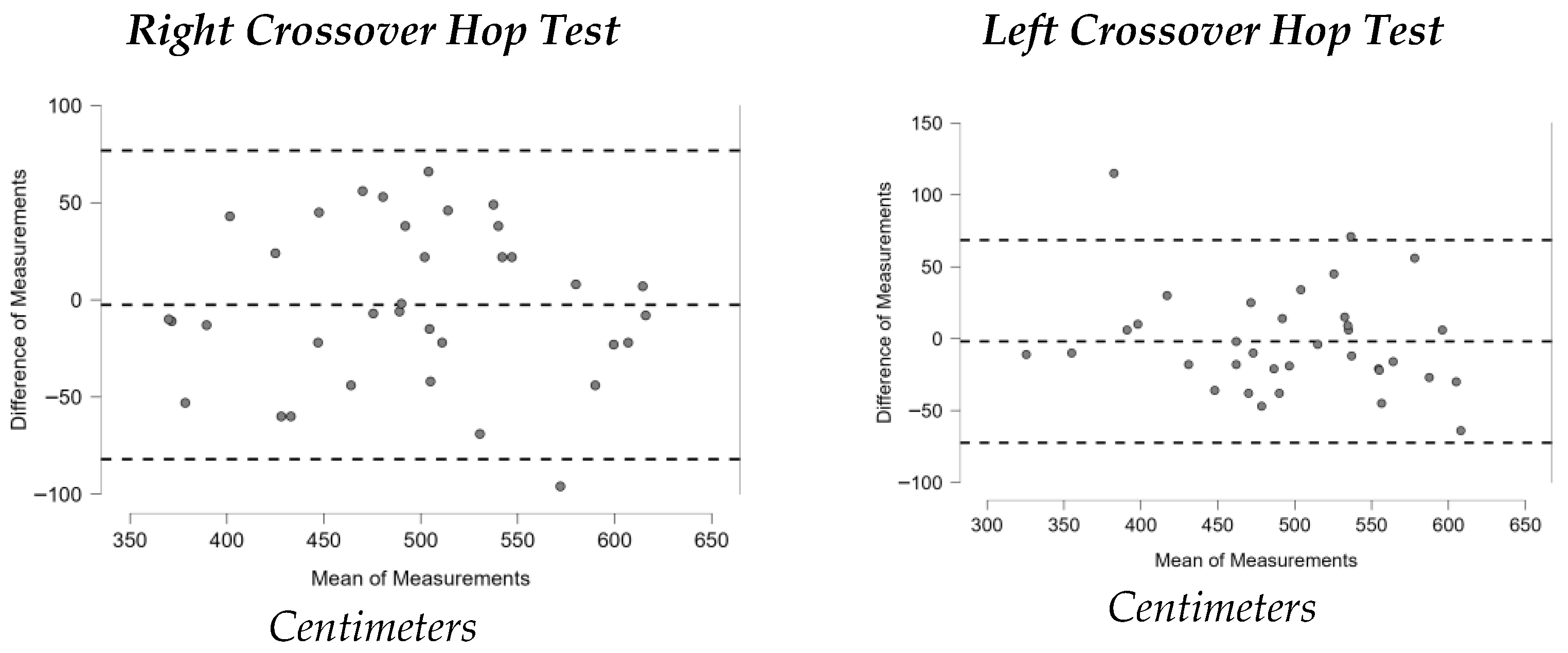
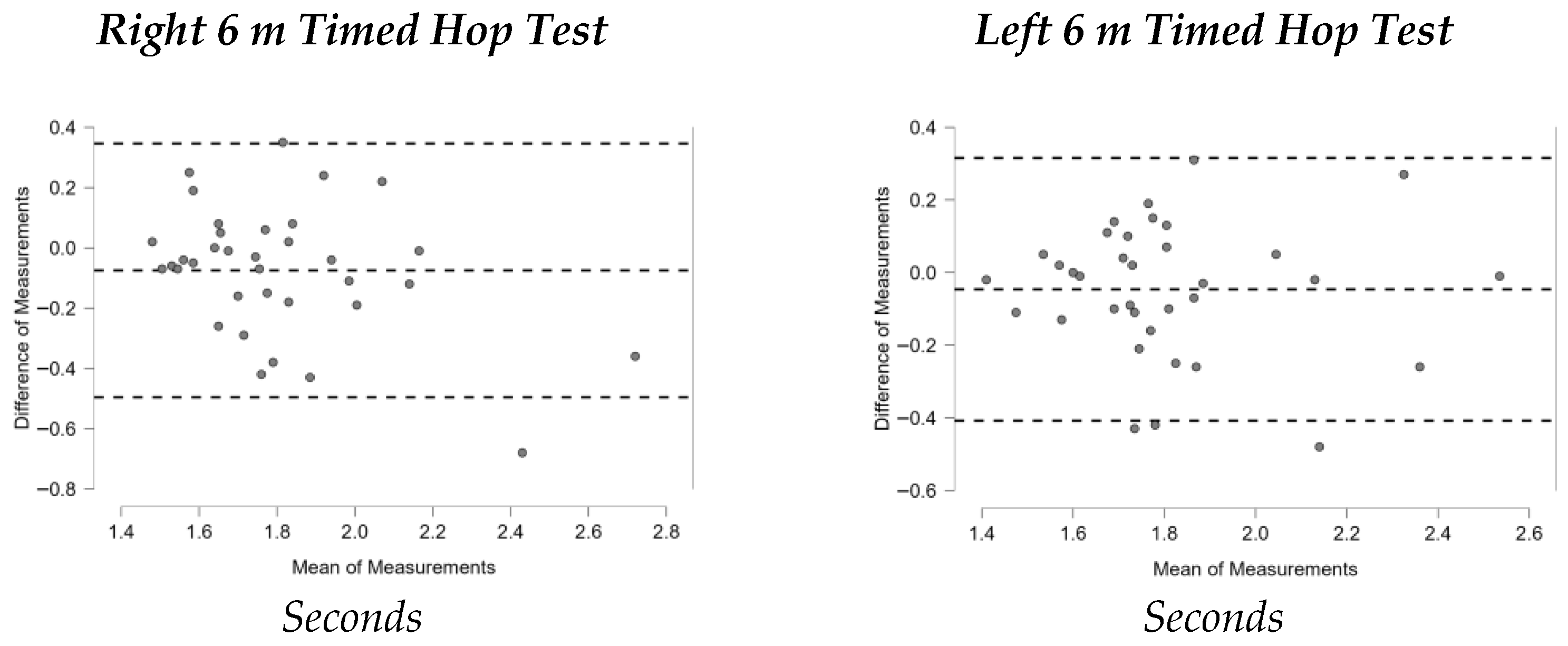

| Variables | (n = 35) |
|---|---|
| Age (years) | 40.49 (8.30) |
| Height (m) | 1.73 (0.05) |
| Weight (Kg) * | 71.93 (7.56) |
| Body Mass Index (kg/m2) * | 24.12 (2.11) |
| Fat Mass (%) * | 18.4 (4.34) |
| Lean Mass (%) * | 39.29 (3.03) |
| Basal Metabolic Rate (Kcal) * | 1638.26 (104.42) |
| Visceral Fat * | 7.14 (2.41) |
| Waist Circumference cm) | 81.34 (6.23) |
| Hip Circumference (cm) | 93.64 (5) |
| Waist-to-hip Ratio | 0.87 (0.44) |
| Right Arm Circumference (cm) | 29.73 (2.74) |
| Left Arm Circumference (cm) | 29.34 (2.78) |
| Right Thigh Circumference (cm) | 55.68 (3.01) |
| Left Thigh Circumference (cm) | 55.27 (3.38) |
| Right Calf Circumference (cm) | 37.14 (1.81) |
| Left Calf Circumference (cm) | 36.98 (1.77) |
| Variable | Mean (SD Test) n = 35 | Mean (SD Test) n = 35 | p | ICC (95% CI) | SEM | SEM (%) | MDC | MDC (%) |
|---|---|---|---|---|---|---|---|---|
| Right Lunge Test Distance (cm) | 11.90 (4.29) | 12.09 (4.39) | 0.074 | 0.990 (0.980–0.995) | 0.434 | 3.62 | 1.2 | 10.03 |
| Right Lunge Test Angle (°) | 56.00 (7.97) | 55.23 (8.03) | 0.099 | 0.941 (0.886–0.969) | 1.94 | 3.49 | 5.39 | 9.68 |
| Left Lunge Test Distance (cm) | 12.27 (3.72) | 12.43 (3.94) | 0.162 | 0.983 (0.967–0.991) | 0.5 | 4.04 | 1.38 | 11.21 |
| Left Lunge Test Angle (°) | 54.89 (6.71) | 54.09 (6.68) | 0.013 | 0.958 (0.919–0.979) | 1.37 | 2.52 | 3.8 | 6.98 |
| Y Balance Test—Right Foot | ||||||||
| Front/Anterior–posterior (cm) | 61.09 (7.95) | 64.21 (8.83) | 0.010 | 0.626 (0.377–0.791) | 5.13 | 8.19 | 14.22 | 22.7 |
| Open/Posterolateral (cm) | 101.61 (10.72) | 105.82 (13.29) | 0.009 | 0.683 (0.459–0.826) | 6.76 | 6.52 | 18.74 | 18.06 |
| Cross/Posterior-medial (cm) | 97.39 (15.42) | 103.81 (14.86) | <0.001 | 0.724 (0.521–0.850) | 7.95 | 7.91 | 22.05 | 21.92 |
| Y Balance Test—Left Foot | ||||||||
| Front/Anterior–posterior (cm) | 59.70 (9.34) | 64.06 (8.81) | 0.002 | 0.554 (0.278–0.746) | 6.06 | 9.79 | 16.9 | 27.15 |
| Open/Posterolateral (cm) | 96.91 (14.89) | 104.24 (12.71) | <0.001 | 0.595 (0.333–0.772) | 8.78 | 8.73 | 24.34 | 24.2 |
| Cross/Posterior-medial (cm) | 94.19 (15.13) | 101.45 (14.35) | <0.001 | 0.732 (0.533–0.855) | 7.63 | 7.8 | 21.15 | 21.62 |
| Right Single Hop Test (cm) | 154.63 (20.41) | 162.57 (20.92) | <0.001 | 0.776 (0.603–0.880) | 9.78 | 6.17 | 27.11 | 17.09 |
| Left Single Hop Test (cm) | 156.23 (22.48) | 162.71 (21.66) | 0.001 | 0.842 (0.711–0.917) | 8.77 | 5.5 | 24.32 | 15.25 |
| Right Triple Hop Test (cm) | 524.94 (67.92) | 543.49 (66.24) | 0.012 | 0.780 (0.608–0.882) | 31.46 | 5.89 | 87.21 | 16.33 |
| Left Triple Hop Test (cm) | 520.94 (70.04) | 537.29 (72.21) | 0.008 | 0.863 (0.748–0.928) | 26.33 | 4.98 | 72.97 | 13.79 |
| Right Crossover Hop Test (cm) | 494.97 (73.29) | 497.54 (73.75) | 0.710 | 0.851 (0.727–0.922) | 28.38 | 5.72 | 78.66 | 15.85 |
| Left Crossover Hop Test (cm) | 494.89 (70.09) | 496.80 (77.05) | 0.755 | 0.884 (0.783–0.939) | 25.06 | 5.05 | 69.45 | 14.01 |
| Right Timed 6m Hop Test (seg) | 1.77 (0.24) | 1.84 (0.32) | 0.051 | 0.691 (0.471–0.831) | 0.16 | 8.62 | 0.43 | 23.9 |
| Left Timed 6m Hop Test (seg) | 1.79 (0.26) | 1.83 (0.27) | 0.263 | 0.741 (0.548–0.860) | 0.13 | 7.45 | 0.37 | 20.65 |
| Airtime CMJ (seg) | 0.48 (0.06) | 0.46 (0.05) | <0.001 | 0.755 (0.568–0.868) | 0.03 | 5.79 | 0.08 | 16.06 |
| Height CMJ (cm) | 28.91 (6.77) | 25.68 (5.69) | <0.001 | 0.753 (0.566–0.867) | 3.1 | 11.34 | 8.58 | 31.44 |
| Power CMJ (W) | 837.60 (156.08) | 788.81 (135.45) | <0.001 | 0.894 (0.802–0.945) | 47.46 | 5.84 | 131.54 | 16.18 |
| Initial Speed CMJ (m/s) | 2.37 (0.28) | 2.23 (0.24) | <0.001 | 0.754 (0.567–0.867) | 0.13 | 5.61 | 0.36 | 15.54 |
Disclaimer/Publisher’s Note: The statements, opinions and data contained in all publications are solely those of the individual author(s) and contributor(s) and not of MDPI and/or the editor(s). MDPI and/or the editor(s) disclaim responsibility for any injury to people or property resulting from any ideas, methods, instructions or products referred to in the content. |
© 2025 by the authors. Licensee MDPI, Basel, Switzerland. This article is an open access article distributed under the terms and conditions of the Creative Commons Attribution (CC BY) license (https://creativecommons.org/licenses/by/4.0/).
Share and Cite
Dominguez-Muñoz, A.; Adsuar, J.C.; Villafaina, S.; Leon-Llamas, J.L.; Dominguez-Muñoz, F.J. Test–Retest Reliability of Ankle Mobility, Balance, and Jump Tests in Amateur Trail Running Athletes. Sports 2025, 13, 352. https://doi.org/10.3390/sports13100352
Dominguez-Muñoz A, Adsuar JC, Villafaina S, Leon-Llamas JL, Dominguez-Muñoz FJ. Test–Retest Reliability of Ankle Mobility, Balance, and Jump Tests in Amateur Trail Running Athletes. Sports. 2025; 13(10):352. https://doi.org/10.3390/sports13100352
Chicago/Turabian StyleDominguez-Muñoz, Alberto, José Carmelo Adsuar, Santos Villafaina, Juan Luis Leon-Llamas, and Francisco Javier Dominguez-Muñoz. 2025. "Test–Retest Reliability of Ankle Mobility, Balance, and Jump Tests in Amateur Trail Running Athletes" Sports 13, no. 10: 352. https://doi.org/10.3390/sports13100352
APA StyleDominguez-Muñoz, A., Adsuar, J. C., Villafaina, S., Leon-Llamas, J. L., & Dominguez-Muñoz, F. J. (2025). Test–Retest Reliability of Ankle Mobility, Balance, and Jump Tests in Amateur Trail Running Athletes. Sports, 13(10), 352. https://doi.org/10.3390/sports13100352










